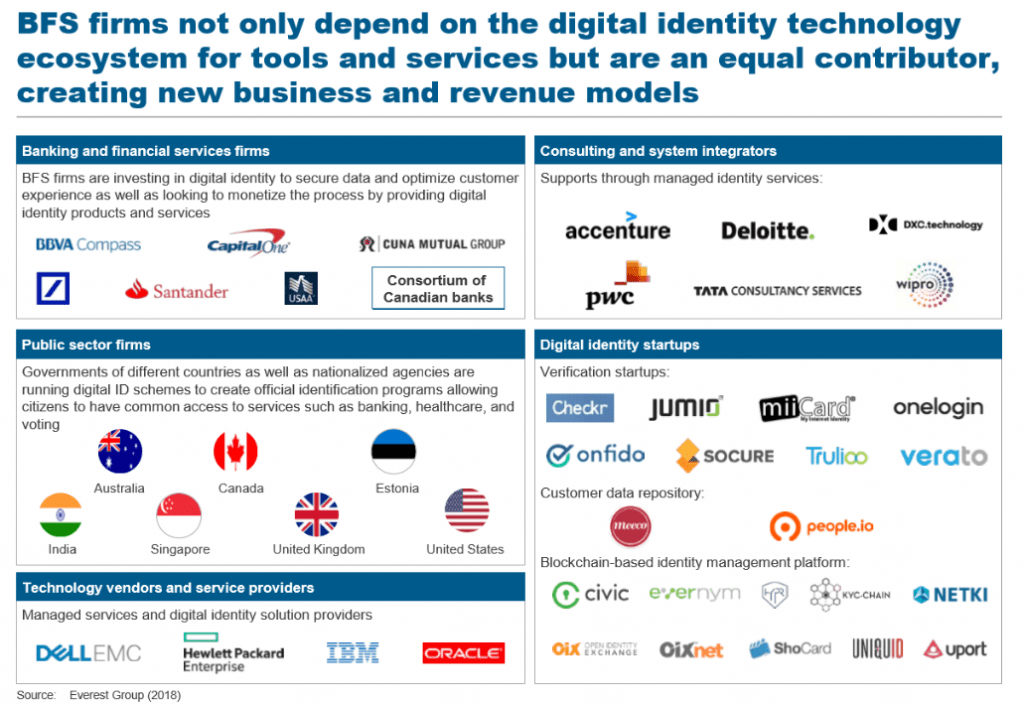Blog
Digital Identity Trends in Banking and Financial Services | Sherpas in Blue Shirts

The meteoric growth in smartphone adoption, increasing preference for digital-first transactions, and mounting concerns over data privacy and the misuse of customer data are pushing firms in consumer-facing industries – particularly in Banking and Financial Services (BFS) – to make significant investments in modernizing their IT infrastructure.
DI solutions
One of the key focus areas is in digital identity (DI) solutions. And it’s a big focal point: the research we conducted to produce our recently released report, “Securing Digital Experiences in Banking and Financial Services – State of Digital Identity Services Market,” shows that the BFS industry’s investment in identity and access management services will grow at a CAGR of over 13 percent to reach US$5.8 billion in 2022.
But BFS firms aren’t focusing on DI solutions solely for data security-type reasons. In fact, they’ve found that having a robust DI strategy can also help them drive their digital transformation agendas. For example:
- Big data & analytics: DI solutions can help avoid unauthorized access to data and insights
- Automation: Automating business processes that access data from multiple systems require a DI solution
- Customer experience: Identity management tools can help drive a consistent omnichannel user experience
- Cloud: DI solutions help manage operational risk of unauthorized access to data on the cloud and digital identity over cloud platforms
- Internet of Things (IoT): Devices that interact with the digital ecosystem need to be uniquely identified and authorized for digital transactions.
A Sampling of DI solution Use Cases
With the emergence of data privacy regulations such as the General Data Protection Regulation (GDPR) and Second Payment Services Directive (PSD2), BFS organizations are quickly building their DI capabilities to ensure better protection.
Related: See our latest banking and financial services research
Indeed, many banks are working in collaboration with government institutions to integrate banking and financial services with DI solutions, and are leveraging APIs, biometrics, blockchain, machine learning, and mobile technologies to allow DI solutions to become more secure and accessible. One example is BBVA Compass, which has been actively investing in the DI space through collaborations with fintech startups, hackathons, and establishment of dedicated firms.
Digital Identity Provider Ecosystem

From a country perspective, Estonia was one of the first to embrace DI. It implemented e-Estonia, which allows citizens to manage e-banking services that can be integrated with other e-commerce solutions, such as PayPal.
Increasing demand for DI-based offerings is also proving to be a breeding ground for new tech-startups, Indeed, the DI provider ecosystem is expanding well beyond the traditional tech vendors/service providers (HPE, IBM, etc.) and consulting and system integrators (e.g., Accenture, Deloitte, and DXC.) All these types of DI tech vendors are embedding AI and machine learning to enhance the capabilities of their DI solutions. For example, in 2018, Mitek, a DI verification company, acquired A2iA, an artificial intelligence (AI) and image analysis company that uses AI and machine learning to create algorithms that process checks, IDs, and documents.
While the current environment requires banks to evolve and actively invest in DI, it also presents them with a unique opportunity to reposition themselves as trustworthy identity aggregators/providers, as they already have secure systems in place to keep information safe. And some banks are already exploring the possibilities of generating revenue from DI solutions. For example, Capital One is one of the first banks in the United States to test if other businesses are willing to pay to check users’ identities with its DI products. And Rabobank entered into a partnership with Signicat in the Dutch market to offer such services as well.
Instead of treating DI as a problem, BFS firms need to embrace it to accelerate their digital transformation journeys, and build new business models to enable revenue opportunities. To further understand the major trends in the DI market, read our report entitled, “Securing Digital Experiences in Banking and Financial Services – State of Digital Identity Services Market.”